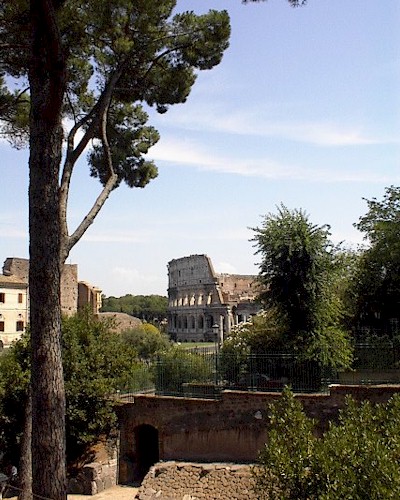|
|
 |
|
Palatine Hill |
|
written
by Lesley Everett / 07.12.2004 |
|
|
| |
Site Location |
| |
The Palatine Hill is one of the seven famous hills of Rome. It’s located between the Forum Romanum, the Velabrum, and the Circus Maximus. The hill slopes up directly from one end of the Roman Forum.
|
| |
|
| |
|
| |
Site History |
| |
Roman legend claims that twin brothers, Romulus and Remus, were abandoned on the Palatine Hill to be "suckled by a she-wolf" around 753 B.C.- archaeologists have established that the hill was occupied as early as the Bronze Age (c. 1500 B.C.) and that by the eighth century B.C. villages had formed on both the Palatine and Aventine hills. In the time of the Republic, Palatine hill was the most desirable residential district for the wealthy and aristocratic- Cicero, Crassus, Augustus, and later emperors each added or expanded vast palaces on the hill in an effort to out-do one another.
Nobody lives on Palatine Hill today, but the remains of many extravagant palaces can be explored in a sort of archaeological museum. Overlooking the Forum are the Farnese Gardens. Numerous varieties of plants including oleanders, boxwoods, rose bushes, and orange trees are planted there.
|
| |
|
| |
|
| |
Elements of Interest |
| |
- The word 'palace' takes its name from the hill- aristocratic Romans built so many magnificent residences that the hill supposedly resembled one immense palace. The last emperor to build on the hill constructed a seven-storied palace (Domus Severiana), which was later dismantled so that all its marble could be reused elsewhere. The name has also been connected to the latin word 'palus,' meaning marsh or swamp, in reference to the swampy area that formerly existed at the Forum and around the hill.
- Things to see include the House of Livia (residence of Emperor Augustus), an Iron Age structure known as Casa di Romolo (Romulus’ Hut), and the remains of an underground passageway that linked the palaces together.
- The hill has some great views, too. From one side you can see the Stadium of Domitian, which is thought to have been used for horse races or was a sunken garden. From another point you can see the Circus Maximus, an extensive grassy area where crowds of up to 200,000 watched chariot races.
|
| |
|
| |
|
| |
Analyze Image |
| |
| |

|
|
| view from Palatine Hill |
|
| |
|
| |

|
|
| Former track or sunken garden |
|
| |
|
| |

|
|
| View of Hill |
|
| |
|
As seen in the "view from Palatine Hill" picture, the lavish mansions and emperors' residences which were built upon Palatine Hill must have had tremendous views of the city. It's no wonder why the hill became the most prestigious, aristocratic area in Rome.
The second picture shows what is thought to have been a former track or sunken garden. Archaeological evidence of many gardens, fountains, and courtyards is easily found amongst the runis. These ornate gardens were often built within and around the palaces in the aristocrats' efforts to out-do one another.
|
| |
|
| |
|
| |
Site Questions |
| |
How many people lived on the hill at one time? How was real-estate and construction handled? Have any architectural plans ever been found?
Are the remaining palace structures and gardens gradually being destroyed/disrupted by tourists? Will the hill ever be used for anything else?
|
| |
|
| |
|
|
 |
|



